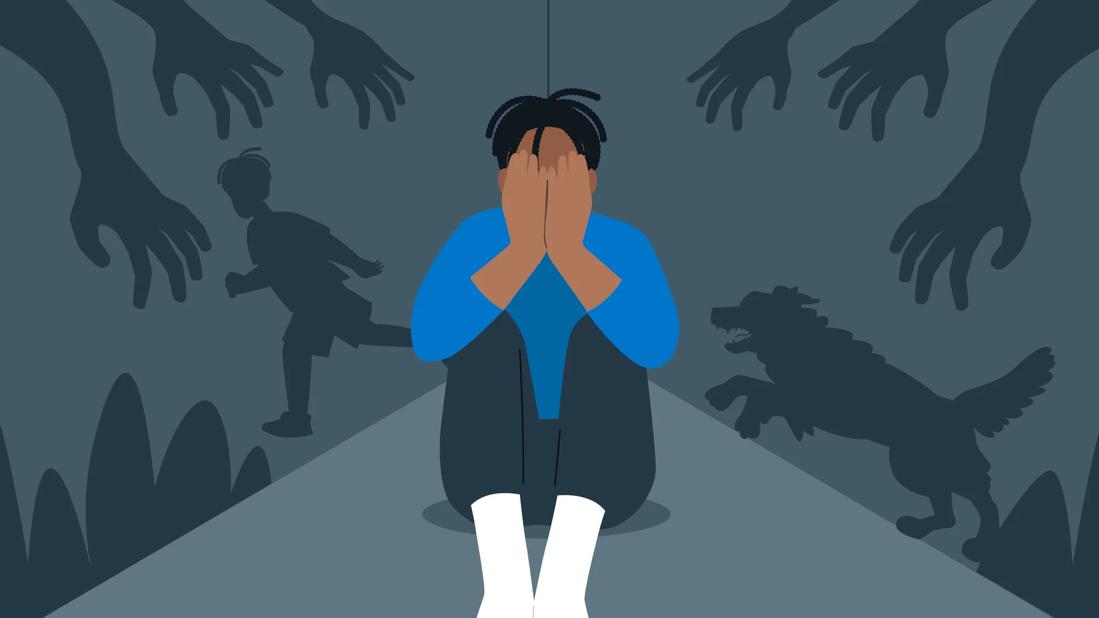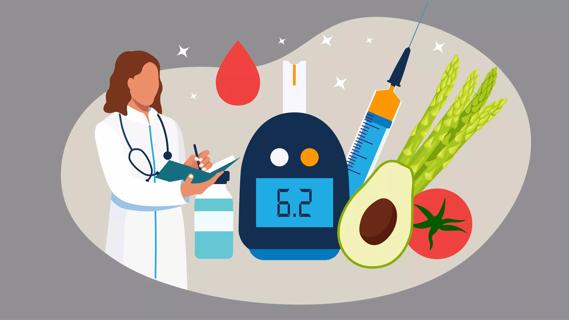In response to stress or danger, your brain responds by either defending itself, running away, stopping or reconciling

Someone cut you off on the highway and you had to swerve and narrowly avoided a collision.
Advertisement
Cleveland Clinic is a non-profit academic medical center. Advertising on our site helps support our mission. We do not endorse non-Cleveland Clinic products or services. Policy
While out for a morning run, an angry dog jumps out onto your path and starts growling and barking at you.
In the second before you turned on the lights in your empty house, your coat rack looked like it was a person standing right next to you.
All three of these scenarios can trigger your body’s natural fight-or-flight response — which is driven by your sympathetic nervous system. Depending on your past experiences, your response to threats may manifest in different ways.
Along with fight-or-flight, you may have also heard of freeze, fawn or a hybrid of several versions. These all can be your body’s reaction to danger and were designed to help you survive stressful and life-threatening situations.
Just a note that you may have heard of this type of reaction also referred to as trauma response, but trauma response can have different meanings, including the triggering of a response to a post-traumatic event. So, in this space, we’re referencing the fight, flight, freeze or fawn as a stress response.
Registered psychotherapist Natacha Duke, MA, RP, helps us understand the different types of stress responses, how they manifest and how you can best manage them.
A stress response is your body’s reaction to a threat, whether it’s real, imagined or perceived. And it can be a normal part of life — helping you to react quickly to stressful or possibly life-threatening situations.
Advertisement
“The fight-or-flight response, or stress response, is triggered by the release of hormones either prompting us to stay and fight or run away,” explains Duke. “During fight-or-flight, our body is working to keep us safe in what we’ve perceived as a dangerous situation.”
And your specific reaction will depend on the trigger itself and whether you’ve had past traumatic experiences.
There are four main trauma responses:
Even if you think you’re not a fighter at heart, we all have that instinctual part of us that will defend ourselves if necessary. And this is an important instinct to have. When confronted with a threat, some individuals may choose to confront it or fight back. This response involves standing up to the danger in an attempt to overcome or subdue it.
As a cat being chased by a dog will show you, sometimes, it’s best to just run. And in those situations, your brain chooses flight. This response involves trying to escape or avoid the threat altogether. When faced with danger, individuals who have a flight response might feel the urge to flee the situation in order to protect themselves.
Another response to danger is your body hitting the pause button altogether. The freeze response involves becoming immobilized or “freezing” in response to a threat. This can involve a state of paralysis or being unable to move. It’s thought that this response might have evolved as a way to avoid being noticed by a predator or to remain still in the hopes that the threat will pass by.
You may have not heard of this fourth “F” before. That’s because the fawn response is a relatively newer addition to the fight, flight, freeze model. It refers to a response where an individual attempts to appease or reconcile the threat in order to avoid harm. This can involve people-pleasing behaviors, submission or attempting to gain favor with the source of danger.
Without even telling it what to do, your body is assessing what’s going on around you and determining your options on how you most likely could survive a given event.
Here’s what can happen during a response to danger (or perceived danger):
Advertisement
During the fight-or-flight response, your body is trying to prioritize, so anything it doesn’t need for immediate survival is placed on the back burner. This means that digestion, reproductive and growth hormone production, and tissue repair are all temporarily halted. Instead, your body is using all its energy on the most crucial priorities and functions.
The stress response can be triggered in a single instant, but how quickly you calm down and return to your natural state is going to vary from person to person (and it will depend on the trigger). Typically, it takes 20 to 30 minutes for your body to return to normal and calm down.
“Our fight-or-flight response was designed to help us survive under life-threatening circumstances,” explains Duke. “Today, there are, arguably, less threats to our survival.”
Back in prehistoric days, danger was all around us and threats were constant. We didn’t know where our next meal was coming from, we had to brave the weather and we had to fight predators waiting to pounce. A rustling bush could be a lion or something else trying to kill you (for its own survival!).
And so our ancestors developed the stress response to help us survive.
Fortunately, in today’s world, imminent danger isn’t lurking around every bend, but that doesn’t mean we’ve lost our ability to trigger the fight-or-flight response. It might happen while you’re on an airplane that’s experiencing turbulence or when someone jumps out at you from a dark room. And it’ll more than likely be triggered if you’re in a car accident, being robbed or experiencing something else traumatic.
Advertisement
Where it gets tricky? It's when your body starts triggering the fight-or-flight response during non-threatening situations — like giving a big presentation, trying to make a deadline at work or merely thinking about a phobia, such as spiders or heights. These situations aren’t truly dangerous, but they’ve triggered our stress response and our body is reacting to them as if they were.
“Our fight-or-flight response can also be activated from psychological or mental stress, such as an important work meeting or even attending a social gathering,” reiterates Duke. “This is only usually a problem if the fight-or-flight response becomes frequent, chronic or disproportionate to the situation.”
Living in a prolonged state of high alert and stress (when there isn’t any real reason for it) can be detrimental to your physical and mental health.
The fight-or-flight response is an important reaction that we all have and need, but it’s meant for authentic stress and danger. If you find that your body is constantly reacting to everyday stress with a flight-or-flight response, you can learn to regain more control.
“Chronic stress can wreak havoc on our immune system, as well as our mental well-being, leading to complications, such as anxiety and depression,” relays Duke.
Advertisement
Things like work, bills, kids, marriage, finances and health are some of the biggest non-life-threatening stressors. How you interpret these things can affect your body’s reaction and contribute to anxiety disorders.
“When stress is spilling over, we become more easily triggered,” says Duke. “For example, we might become overwhelmed with dishes or laundry or have less patience with our kids. This is a clear sign that we need to carve out more time for self-care and cultivate healthier coping strategies that will help us in the long term.”
Often, hardships from our past can stick with us in more ways than one. Some people who get in a car accident are afraid to drive again or can’t drive past the spot where the accident occurred because of fear and anxiety. It becomes a generalized fear response to a situation that isn’t particularly dangerous anymore.
This can also happen with work or strained relationships. The next thing you know, your fight-or-flight response is falsely activated, putting you in a state of chronic stress.
“I recommend carving out time to write down your signs and symptoms of stress,” advises Duke. “For some people, it might be poor sleep, for others, it might be irritability or stress eating. Understanding your stress signs and symptoms is an important step for improving your levels of stress because you can intervene earlier.”
The fight-or-flight response has a clear purpose and function, but it shouldn’t be activated over everyday, non-threatening stressors like traffic, emails or bills. And if it is, the goal is to develop an awareness when the response is activated and be able to bring yourself back to baseline.
It can help to have a response to your stress response. These can be mindful practices like yoga, meditation or even a couple minutes of breathwork.
Managing your stress response is critical to your overall health. It’s important to think big picture when you feel yourself starting to get worked up over something that you know isn’t a true threat or danger.
If you’re at the point where stress is impacting your quality of life, you may benefit from talking to a healthcare provider. Therapy, medication and stress management techniques can help you gain a more balanced state. With time and practice, you can learn to manage your stress response so it doesn’t do more harm than good.
Learn more about our editorial process.
Advertisement

Ground yourself in evidence, name your thoughts out loud and meet yourself in the middle to help defuse worst-case scenarios

Fill your coping toolbelt with healthy skills like getting outside, writing in a journal, volunteering, laughing or talking with a friend

We all experience some stress from time to time, but chronic stress can contribute to health issues like diabetes and cardiovascular disease

Getting outside, eating a healthy diet, taking up journaling, listening to music — even cuddling a pet — can provide stress relief

Give these 30+ grocery items a try to help find relief

A diabetes diagnosis, new or long-standing, can trigger reactions like grief, stress, depression and frustration, but symptom relief and help are available

From nausea, weight gain and eczema, stress can affect your immune system in many ways

When your senses start to feel overwhelmed, practices like deep breathing can help

If you’re feeling short of breath, sleep can be tough — propping yourself up or sleeping on your side may help

If you fear the unknown or find yourself needing reassurance often, you may identify with this attachment style

If you’re looking to boost your gut health, it’s better to get fiber from whole foods